There is nothing on Earth quite like cooking in a Dutch oven over an open fire. A well-seasoned Dutch oven is so valuable it is often a family heirloom, creating nutritious meals from scratch and nourishing your loved ones.
Cooking from scratch inside a Dutch oven is an art that is slowly becoming lost due to modern conveniences. People short on time or money might opt for a frozen processed meal instead of cooking a meal from scratch. The frozen meal is easier to prepare, but has significantly less nutrients and more chemicals inside than a homemade meal.
Dutch ovens have been a part of the American economy since the 1700s. They are made of cast-iron from molds that vary in size, usually 8 inches to 16 inches. The matching lid has a lip attachment on top to keep coals securely in place, should you want to cover your Dutch oven for more heat. The steel handle allows you to remove it from the fire or wood stove without touching the hot pan.
A well-made Dutch oven will last centuries. Generations can pass down their skillets to their kids and the cast-iron flavor will improve with time and use (just be sure to never use soap when washing it!)
Related: The Lost Art of Scratch Cooking
It’s time to bring back a delicious, healthy, and peaceful tradition of cooking scratch-made meals inside a Dutch oven.
Cooking Over a Fire
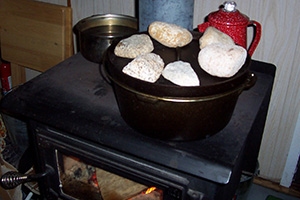 A Dutch oven is made to use over an open fire or woodstove.
A Dutch oven is made to use over an open fire or woodstove.
This means it works inside or outside, depending on where your fire is.
The oven is made to withstand high direct heat, so it can be placed and buried directly under hot coals or in your fireplace.
The seasoning from the pan mixed with the smokiness of the fire creates dishes that are unique and unlike anything you’ve ever tasted.
To get Dutch oven scratch-cooking perfectly right, there are a few tool recommendations to help you out. You are working with hot coals, so having long barbecue tongs help to move the coals around the oven to control the heat.
I also like to keep a whisk broom on-site so that any coal debris on top of the lid can be swept away and not into the food. It makes opening it much cleaner.
Get the Most Out of Scratch Cooking
When making stews and soups, or meat with lots of connective tissue, you want a cooking vessel that can accommodate one-pot cooking. All of the Dutch oven recipes of yesteryear were done in the same pot and cooked all day long.
The fruits of your labor were celebrated at dinnertime when you’re rewarded with a smoky, slow-cooked dish that will keep you satiated until morning.
Related: How to Make 2400 Calorie Emergency Ration Bars Designed to Feed You for a Full Day
Building a flavor base is super important when cooking from scratch in a Dutch oven.
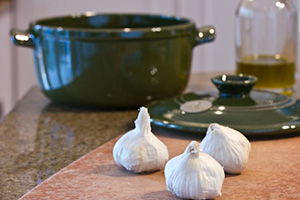
The pot itself lends a lot of flavor to what you’re cooking, but having a foundation of flavor from aromatics is the best way to start a recipe.
By sweating onions, garlic, freshly picked garlic scapes, carrots, and celery you are building flavors that will permeate the rest of the dish.
In that same realm, it is important to sear your meat inside the Dutch oven before leaving it to cook. Searing the meat inside the cast-iron provides a deep flavor that you only get from deeply browned meat.
Your dish will still be delicious if you simply throw all ingredients into it at the same time, but if you can spare the extra time, it’s worth it.
The Best From-Scratch Foods to Cook In a Dutch Oven
There was a time when all meals were made inside the Dutch oven over a fire. Eggs and meats or potatoes were cooked for breakfast, soup or stew for lunch and dinner. It is truly a historical staple in open-fire cooking.
Related: 7 Primitive Cooking Methods You Still Need to Know Today
With the mainstream kitchen having many modern conveniences, there is no longer a need to cook over an open fire anymore. Us preppers and campers are the folks still holding on to this awesome tradition.
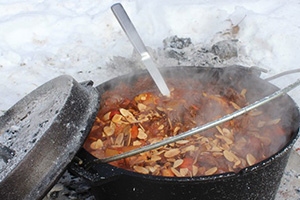 Call me old-fashioned, but my favorite meals in the Dutch oven are foraged, hunted, and caught meals. When my rabbit trap is set off, I know cast-iron rabbit stew is in my near future.
Call me old-fashioned, but my favorite meals in the Dutch oven are foraged, hunted, and caught meals. When my rabbit trap is set off, I know cast-iron rabbit stew is in my near future.
During deer season, a venison stew is best cooked in a well-seasoned Dutch oven with whole carrots, potatoes, parsnips, onions, and garlic.
Using foraged mushrooms and garlic scapes also will make a tasty and nutritious soup.
For a cheap and filling meal while off-the-grid, make a large pot of beans over the open fire. Dried beans last a long time, are usually kept stocked in your pantry, and are a healthy meal that fills you up. Add some bacon, carrots, onions, or whatever aromatics you may have.
Another great scratch-made meal to make in a Dutch oven is breakfast. Adding some bacon and eggs to the Dutch oven is cheap and filling. You could also bake bread or biscuits inside for a really warm and comforting treat.
Bread inside of a Dutch oven is the most delicious bread you will ever eat.
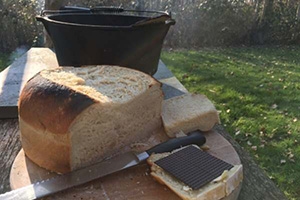
The cast-iron pot has very even heating, so homemade bread can bake inside with the lid on!
Simply make a dough, allow to rise, add to the skillet with a lid, and place over the fire. Add coals to the lid to add head all around the pot. In an hour, you have fresh crusty bread to last through the week!
The options are limitless when it comes to cooking in a Dutch oven.
The Dutch Oven – Your Next Prepper Purchase
All preppers and foodies alike should have a high-quality Dutch oven in their home. It not only creates the most delicious dishes from scratch but also provides you with a tool for cooking over an open fire.
Dutch oven cooking over the fire is a lost art that should be revived, not only for survival purposes but because the process is fun and worthwhile in terms of flavor. Old-timers will know that the longer you use your Dutch oven, the more flavorful it becomes.
Don’t waste any more time, get to cooking in your Dutch oven!
You may also like:
 How to Clean Cooking Gear with Wood Ash
How to Clean Cooking Gear with Wood Ash
An Insanely Effective Way to Build a 5 Year Food Stockpile (Video)
Classified FEMA Report Confirms Preppers’ Worst Fears
DIY Candle Lantern From A Soda Can
How to Identify and Use Kratom – the Painkilling Plant that Substitutes Opioids

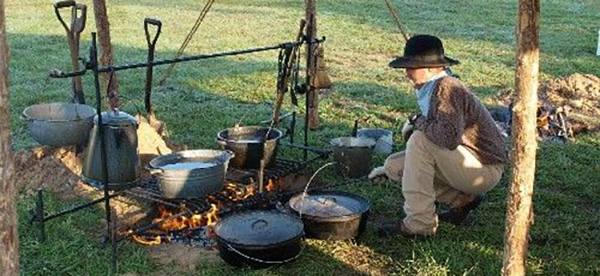













Get a recipe. Cook book as well.
It’s a myth about using soap. A properly seasoned skillet or Dutch oven will not be ruined by using a little soap. Go ahead, clean it and always apply a light coat of oil after every use. You’ll be fine.
We have several pieces of century plus age cast iron. We use a little bit of soap and it has never done any harm to the seasoning. Our oldest piece is lat 1700’s all the way to 1920’s. They get used regularly as that is what we have.
Great food. We have several recipe books as well.
If properly taken care of, you will NEVER need to use soap on cast iron. We NEVER have!
Seriously Folks! What would the World be like without Dutch Ovens, Cast Iron Skillets, and those nifty Bakeware pieces with all the assorted imprints. Life is Good when you cook with wood.
We use our Abelskever pan all the time. Kids just love pancake balls.
A list of manufacturers who still make a quality product would be very helpful. Some of the old line cast iron cookware manufacturers are now sourcing their products in China with the typical results.
Unfortunate buyers who rely on past performance are in for a disappointment when Hecho in Shina shows up on the dutch oven.
Chuck…there are some manufacturers currently making quality iron…like Blacklock…but you’ll have to sell your first born to afford it. I cook exclusively on garage sale and flea market iron…good skillets can be had for a few bucks…the dirtier the better. They’re easily cleaned with a lye bath and scrubbing with steel wool. Lots of how to info online. Some now defunct names like Wagner or Griswold will fetch a bit more if the seller knows what he has, but you can luck out too. The 40, 50 year and older iron cooks and looks much better than the new Lodge iron. Keep your eyes open and grab what you can when you can.
Lodge Cast Iron. I know nothing about the “New” Losge cast iron, and I have just about everything there is. All is Lodge Some is over 100 years old, others are only 10-15 years. All the same quality as far as I can tell. It goes from open fire, to propane or on top of a wood burner and back onto a glass top. All seems the same for the last 50 or so years.
It’s about the interior finish. “New” Lodge skillets have a rough surface. The older one notch and 3 notch skillets were polished and much easier to properly season. I’ve “rescued” a couple of the new ones by taking an orbital sander to the inside. Re-seasoned with organic flax seed oil…4 coats.
Here is a decent list of the cast iron makers
https://en.wikipedia.org/wiki/List_of_cast-iron_cookware_manufacturers
Good list. Most of these companies are long out of business.
Stumps: Great article. Wikipedia, of course, but sometimes it helps to know what Wiki called it. I have found great information with a heading I would have never guessed. Thanks for the reference.
I have three types of Dutch ovens. The first is the traditional one with three legs on the bottom and a lipped lid on top. I’ve found that aside from being able to easily put coals under and on top, it also works well on a gas stovetop (for searing) and in a regular oven. It doesn’t work on an electric stove because it sits above the burners on its legs, and would have the same problem on top of a wood-burning stove.
The second is the flat-bottom Dutch oven with the lipped lid. That works on the electric stove or on a wood-burning stove, but can be problematic to set directly on coals without some other support. The coals can shift or get smothered.
The third is flat-bottom and no-lip top. The coals can’t stay on top and as the last are problematic on bottom, so cooking with coals doesn’t work very well. They do work well on any stove-top and in the oven. Aside from the plain cast iron, you can also get them enameled.
That part of the wonder of the Dutch over…you can use it so many ways, from stove-top to in the oven to off-the-grid or camping using coals. Aside from those all-in-one meals, you can make good pizza, desserts, and anything else you might do in a skillet or a pot, though it can be difficult to flip pancakes or eggs in it…but that’s where you turn the lid upside-down on the fire or coals and use it.
There’s a show on youtube about repurposing iron parts (brake drums and so on) into cast iron. https://www.youtube.com/watch?v=K_qyoxX8fXc
is a start of something very cool.
Red
Yes, That was a very cool video to watch.
I would like to make one, but much bigger. That was cool. Thanks. Now looking to maybe make one my self. I work with metals of all kinds. Will be a Lot of work. But cool.
Iron is a wonder for your lawn and garden also.
Iron is locked up down here, too much calcium, but yes, working iron is cool. Dad made some things in the forge when we still had horses. niio